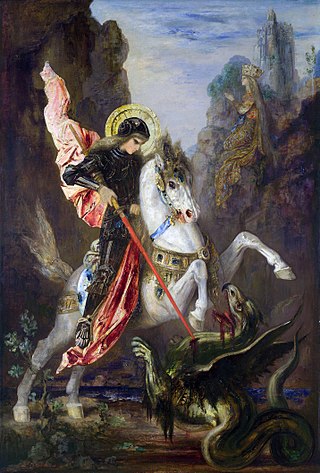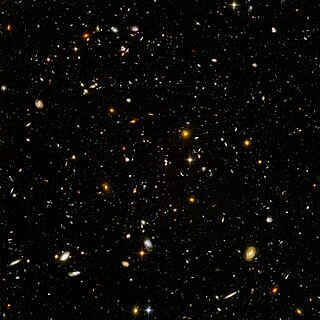
Christian mythology is the body of myths associated with Christianity. The term encompasses a broad variety of legends and narratives, especially those considered sacred narratives. Mythological themes and elements occur throughout Christian literature, including recurring myths such as ascending a mountain, the axis mundi, myths of combat, descent into the Underworld, accounts of a dying-and-rising god, a flood myth, stories about the founding of a tribe or city, and myths about great heroes of the past, paradises, and self-sacrifice.

The universe is all of space and time and their contents. It comprises all of existence, any fundamental interaction, physical process and physical constant, and therefore all forms of energy and matter, and the structures they form, from sub-atomic particles to entire galaxies. Space and time, according to the prevailing cosmological theory of the Big Bang, emerged together 13.787±0.020 billion years ago, and the universe has been expanding ever since. Today the universe has expanded into an age and size that is physically only in parts observable as the observable universe, which is approximately 93 billion light-years in diameter at the present day, while the spatial size, if any, of the entire universe is unknown.
A creator deity or creator god is a deity responsible for the creation of the Earth, world, and universe in human religion and mythology. In monotheism, the single God is often also the creator. A number of monolatristic traditions separate a secondary creator from a primary transcendent being, identified as a primary creator.

The cosmic egg, world egg or mundane egg is a mythological motif found in the cosmogonies of many cultures that is present in Proto-Indo-European culture and other cultures and civilizations. Typically, the world egg is a beginning of some sort, and the universe or some primordial being comes into existence by "hatching" from the egg, sometimes lain on the primordial waters of the Earth. Typically, the upper half of the egg, or its outer shell, becomes the heaven (firmament) and the lower half, or the inner yolk, becomes the Earth. The motif likely stems from simple elements of an egg, including its ability to offer nourishment and give rise to new life, as is reflected by the Latin proverb omne vivum ex ovo.

Proto-Indo-European mythology is the body of myths and deities associated with the Proto-Indo-Europeans, speakers of the hypothesized Proto-Indo-European language. Although the mythological motifs are not directly attested – since Proto-Indo-European speakers lived in preliterate societies – scholars of comparative mythology have reconstructed details from inherited similarities found among Indo-European languages, based on the assumption that parts of the Proto-Indo-Europeans' original belief systems survived in the daughter traditions.

Religious cosmology is an explanation of the origin, evolution, and eventual fate of the universe from a religious perspective. This may include beliefs on origin in the form of a creation myth, subsequent evolution, current organizational form and nature, and eventual fate or destiny. There are various traditions in religion or religious mythology asserting how and why everything is the way it is and the significance of it all. Religious cosmologies describe the spatial lay-out of the universe in terms of the world in which people typically dwell as well as other dimensions, such as the seven dimensions of religion; these are ritual, experiential and emotional, narrative and mythical, doctrinal, ethical, social, and material.
Chinese creation myths are symbolic narratives about the origins of the universe, earth, and life. Myths in China vary from culture to culture. In Chinese mythology, the term "cosmogonic myth" or "origin myth" is more accurate than "creation myth", since very few stories involve a creator deity or divine will. Chinese creation myths fundamentally differ from monotheistic traditions with one authorized version, such as the Judeo-Christian Genesis creation narrative: Chinese classics record numerous and contradictory origin myths. Traditionally, the world was created on Chinese New Year and the animals, people, and many deities were created during its 15 days.

Anu or Anum, originally An, was the divine personification of the sky, king of the gods, and ancestor of many of the deities in ancient Mesopotamian religion. He was regarded as a source of both divine and human kingship, and opens the enumerations of deities in many Mesopotamian texts. At the same time, his role was largely passive, and he was not commonly worshipped. It is sometimes proposed that the Eanna temple located in Uruk originally belonged to him, rather than Inanna, but while he is well attested as one of its divine inhabitants, there is no evidence that the main deity of the temple ever changed, and Inanna was already associated with it in the earliest sources. After it declined, a new theological system developed in the same city under Seleucid rule, resulting in Anu being redefined as an active deity. As a result he was actively worshipped by inhabitants of the city in the final centuries of the history of ancient Mesopotamia.
Myth is a genre of folklore or theology consisting primarily of narratives that play a fundamental role in a society, such as foundational tales or origin myths. For folklorists, historians, philosophers or theologians this is very different from the use of "myth" simply indicating that something is not true. Instead, the truth value of a myth is not a defining criterion.

The creation of life from clay can be seen as a miraculous birth theme that appears throughout world religions and mythologies. It can also be seen as one of gods who craft humans out of earthly materials. As such, this class of story falls within a larger set of divine or cosmogonic origin stories about creation, whether through divine emergence or divine craft.

A deity or god is a supernatural being considered to be sacred and worthy of worship due to having authority over the universe, nature or human life. The Oxford Dictionary of English defines deity as a god or goddess, or anything revered as divine. C. Scott Littleton defines a deity as "a being with powers greater than those of ordinary humans, but who interacts with humans, positively or negatively, in ways that carry humans to new levels of consciousness, beyond the grounded preoccupations of ordinary life".
*Manu and *Yemo were a duo in Proto-Indo-European mythology. In the creation myth, Manu kills Yemo as a foundational part of the origin of the universe. Yemo is sometimes also interpreted as a primordial hermaphrodite.







